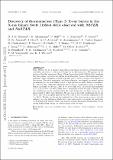Discovery of thermonuclear (Type I) X-ray bursts in the X-ray binary Swift J1858.6–0814 observed with NICER and NuSTAR
Author(s)
Buisson, DJK; Altamirano, D; Bult, P; Mancuso, GC; Güver, T; Jaisawal, GK; Hare, J; Albayati, AC; Arzoumanian, Z; Castro Segura, N; Chakrabarty, D; Gandhi, P; Guillot, S; Homan, J; Gendreau, KC; Jiang, J; Malacaria, C; Miller, JM; Özbey Arabacı, M; Remillard, R; Strohmayer, TE; Tombesi, F; Tomsick, JA; Vincentelli, FM; Walton, DJ; ... Show more Show less
DownloadSubmitted version (1.019Mb)
Open Access Policy
Open Access Policy
Creative Commons Attribution-Noncommercial-Share Alike
Terms of use
Metadata
Show full item recordAbstract
© 2020 Oxford University Press. All rights reserved. Swift J1858.6-0814 is a recently discovered X-ray binary notable for extremely strong variability (by factors of >100 in soft X-rays) in its discovery state. We present the detection of five thermonuclear (Type I) X-ray bursts from Swift J1858.6-0814, implying that the compact object in the system is a neutron star (NS). Some of the bursts show photospheric radius expansion, so their peak flux can be used to estimate the distance to the system. The peak luminosity, and hence distance, can depend on several system parameters; for the most likely values, a high inclination and a helium atmosphere, D = 12.8+0.8-0.6kpc, although systematic effects allow a conservative range of 9-18 kpc. Before one burst, we detect a QPO at 9.6 ± 0.5 mHz with a fractional rms amplitude of 2.2 ± 0.2 per cent (0.5-10 keV), likely due to marginally stable burning of helium; similar oscillations may be present before the other bursts but the light curves are not long enough to allow their detection. We also search for burst oscillations but do not detect any, with an upper limit in the best case of 15 per cent fractional amplitude (over 1-8 keV). Finally, we discuss the implications of the NS accretor and this distance on other inferences which have been made about the system. In particular, we find that Swift J1858.6-0814 was observed at super-Eddington luminosities at least during bright flares during the variable stage of its outburst.
Date issued
2020Department
MIT Kavli Institute for Astrophysics and Space ResearchJournal
Monthly Notices of the Royal Astronomical Society
Publisher
Oxford University Press (OUP)
Citation
Buisson, DJK, Altamirano, D, Bult, P, Mancuso, GC, Güver, T et al. 2020. "Discovery of thermonuclear (Type I) X-ray bursts in the X-ray binary Swift J1858.6–0814 observed with NICER and NuSTAR." Monthly Notices of the Royal Astronomical Society, 499 (1).
Version: Original manuscript